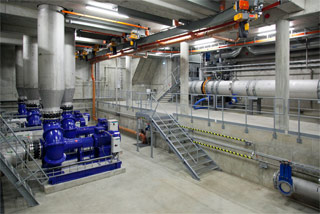Wastewater treatment
We treat the wastewater collected in Tallinn and nearest surrounding areas, using environmentally friendly and modern technologies at Paljassaare Wastewater Treatment Plant. In 2014 42.99 million m3 of wastewater was treated at Paljassaare Wastewater Treatment Plant.
The quality of effluent discharged to the sea is set by the legal acts and the water extraction permit no L.VV/322982. The concentration of pollutants in wastewater arriving to the treatment plant and in the effluent leaving the plant are monitored to assess the efficiency of the treatment process and the quality of effluent. In 2014, the wastewater laboratory carried out 47,000 analyses at different treatment stages in the plant.
The important pollution parameters for us are the following:
- BOD7 (biological oxygen demand shows the amount of oxygen required for the defined biological decomposition of organic matter in the course of 7 days);
- CODCr (chemical oxygen demand is a measure of the decomposition of organic matter, measured as the consumption of oxygen in chemical oxidation of all organic matter in water);
- SS (suspended solids shows the volume of solid matter in water which is caught in a filter with a defined mesh size);
- Ntotal and Ptotal (total phosphorus and total nitrogen are elements contained in nutrient salts, which increase the growth of plankton in water. If the content of nutrient salts is too high, the growth can be so strong that oxygen is used up and a shortage of oxygen arises);
- Oil products (show the amount of light (e.g. petroleum) and heavy (e.g. heavy fuel oil) oil products).
Wastewater volumes were similar to the previous year but the pollution loads in 2014 were mostly lower than previously. Only a slight increase was seen in phosphorus and nitrogen loads in influent. The level of pollutants discharged with effluent were at the same level.
Paljassaare Wastewater Treatment Plant is already today achieving a high quality of effluent. We continue to be committed to maintaining the high standards and outperforming the norms established for the effluent discharged to the Baltic Sea. In the reporting year, the operation in all stages of the treatment process was continuously improved and equipment upgraded as planned. Along with the renewal of the aeration system also the mixers in activated sludge process were replaced.
Pursuant to the change of law, since 2013, our main challenge has been achieving the new maximum allowed level of total phosphorus (0.50 mg/l). Despite a relatively stable annual average, the phosphorus concentration in the incoming wastewater fluctuates quite a lot throughout a year. To manage the treatment process better, we plan to reconstruct the coagulant dosing point by 2016.
As a result of the investments made in the Paljassaare Wastewater Treatment Plant, Tallinn has been removed from the hotspots list of Helsinki Commission for the protection of the Baltic marine environment. HELCOM organises international cooperation on the basis of the Convention on the protection of the Marine Environment of the Baltic Sea area against all pollution sources and to restore as well as to protect its ecological balance. By the end of 2014, the wastewater treatment results were in compliance with the HELCOM and legal requirements.
Wastewater outlets to the sea
The 2014 level of precipitation was similar to that of 2013. During 2014, we were twice (in June and July) bound to open the emergency outlets in the Wastewater Treatment Plant for a short period of time during heavy showers to avoid major damages. However, due to generally very good weather and excellent operating performance very little, i.e. total of 1303 m3 of wastewater diluted by storm water (dilution ¼) was conducted to the sea.
Throughout the year 2014, 224,485 m3 of highly diluted wastewater, which underwent mechanical treatment, was discharged to the sea through the deep-sea outlet due to the shock loads, which exceeded the biological treatment capacity.
Pollution tax
As a water company we are required to act in line with the environmental permits and pay pollution tax with the aim to avoid and reduce the potential damage caused by pollutants or waste discharged to the environment.
The calculation of pollution tax is established in the permit for the special use of water and the Environmental Charges Act and is applied to the pollutants contained in the effluent and storm water at the particular outlets. Both the receiving water coefficient of the specific outlet as well as compliance with the pollutant limit value in effluent are taken into account in pollution charge calculations.
In 2014, we complied with the conditions serving as the basis for the fee for the special use of water established in the permits for the special use of water, except for the heavy metals (Zn and Cu) in QI and QII. In QIV 2013, the limit values set for hazardous substances (Zn and Cu) were amended in the permit for the special use of water as per the legislation. Consequently, the limit values were reduced by ca 400 times with a short notice and the technology used in Paljassaare Wastewater Treatment Plant was not able to achieve those limit values. This was the reason, why higher pollution tax was paid for QI and QII in 2014. Since QIII 2014 a mixing zone has been established for us by Environmental Board for the next ten years and after that period the effluent will have to comply with the applicable legal requirements.
In 2014, the pollution tax paid for discharging pollutants into receiving waters formed 9.7% of the cost of services sold.






